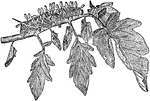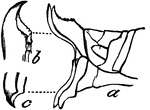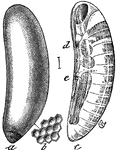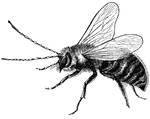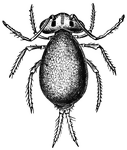Bruchus Pisi
Pictured are the beetle of the natural size (a), and enlarged (b), and a pea (c) in which the hole of…
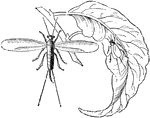
Lecanium Persicae
Pictured is a leaf with a male on it, slightly enlarge (a) and a male flying, much enlarged (b). Lecanium…
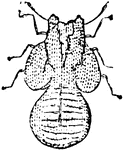
Larva of Psylla Pyrisuga
The larva of psylla pyrisuga live on pear trees and sometimes apple trees. The larvae suck the juice…
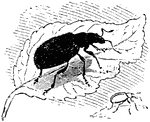
Phyllobius Oblongus
Phyllobius is a genus of small beetles. The oblongus variety has a short, thick beak. The antennae arise…
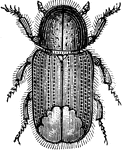
Tomicus Laricis
Tomicus laricis is a pine bark beetle. The bodies of the beetles are cylindrical and the wing cases…

Pissodes Notatus
Pissodes notatus is a pine weevil. Pictured is the insect and the ravages to a tree trunk committed…

Pine Beauty Moth
Pine beauty moth is the common name of trachea piniperda. This moth is a heavy bodied insect with variegated…

Wooly Aphis on Alnus
Woolly aphis is a plant lice. Eggs are attached to twigs during the winter. In the spring soft-bodied,…
Flat-Headed Borer
Flat-Headed Borer is the common name of Chalcophora virginiensis. The insect extendsd its flattened…

Phylloxera Galls on Chestnut
Pictured are phylloxera galls on chestnut. Insect larvae cause malformations or swellings of the leaves…
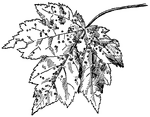
Mite Galls on Maple
Pictured are mite galls on maple. The galls are malformations or swellings caused by the insect.
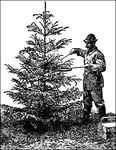
Food Tree
Illustrated is a man pouring food onto a "food tree" for birds. A food tree imitates a coniferous tree…

Venus Fly Trap
Venus Fly Trap is the common name of dionaea muscipula. The plant is insectivorous, meaning it eats…
Insect Life Stages
Illustrated are the four stages in an insects' life: egg, larva, pupa, imago. The insect pictured is…

Promethea Moth Cocoon
The cocoon of the promethea moth is made in the roll of a leaf. The insect weaves a web around the leaf…

San Jose Scale
Pictured is the mature winter scale. Also shown is the insect itself with it threadlike feeding organs.

Hemipterous Insect
Illustrated is a hemipterous insect, considered to be a true bug. It belongs to the order hemiptera.
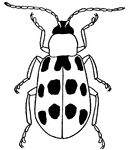
Corn Rootworm
A destructive insect of corn. Also called a cucumber beetle. Diabrotica is the name of the genus with…

Argentine Ant
Image of an Argentine ant. This destructive insect is native to parts of South America, but was accidentally…

Gadfly of Sheep
The Gadfly of the sheep lays its eggs in the nostrils of the sheep. There, the maggots hatch and live…
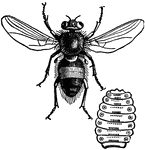
Gadfly of Ox
This illustration shows the Gadfly of the Ox. This illustration is enlarged, and also shows a Gadfly…
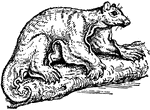
Galeopithecus
Galeopithecus is the generic name of certain mammals from the Malayan region, commonly (incorrectly)…

Gall-fly
Gall-fly is a name applied to the members of the family Cynipidae, which are not flies, but are related…
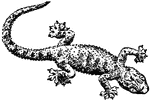
Gecko
A gecko is a small, four-footed member of the lizard family Geckonidae. Geckos are widely distributed…
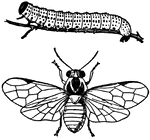
Gooseberry Caterpillar (Nematus ribesii) and Sawfly
Gooseberry Caterpillar is the name applied to the larvæ of two different insects, both injurious to…

Phylloxera-mite
A phylloxera. Typically found in eastern North America, and related to the aphid, they typically feed…
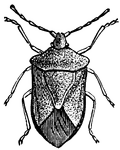
Plant-bug
Dotted leg plant-bug, one of many different heteropterous insects which suck the juices of plants.

Satellite Sphinx Moth
"Philampelus satellitia, a large and handsome hawk-moth whose larva feeds upon the vine. Natural size.…
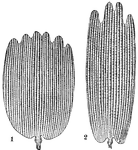
Scales from the Wings of a Butterfly
"Scales from the wings of a butterfly, Vanessa antiopa, highly magnified. 1. from border of anterior…

Maize Kernels Destroyed by Maggots
Illustration of two small corn (maize) kernels being eaten by maggots. One maggot is still inside one…

Semisagittate Mark
"In entomology, shaped like the longitudinal half of a barbed arrow-head, or like the barbed end of…

Siro Americanus
"The typical genus of Sironidae. Two species inhabit Europe, one the Philippines, and another (undescribed)…
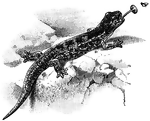
Red Salamander Eating an Insect
Spelerpes ruber. "...of a bright red color, more or less spotted with black, and is found in cold springs…


